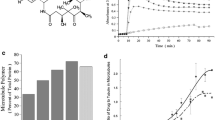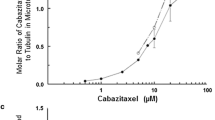Abstract
Purpose
The dynamic instability of microtubules in cells is one of the key targets of anticancer therapeutics. Microtubule-disrupting agents such as vinca alkaloids and microtubule-stabilizing agents such as taxanes are important antitumor agents. The bone marrow toxicity and human tumor xenograft activity of three tubulin-binding compounds, vincristine, paclitaxel, and tasidotin were compared.
Methods
Mouse and human bone marrow were subjected to colony-forming (CFU-GM) assays over a 5-log concentration range in culture. In vivo, a range of tasidotin doses was compared with vincristine, paclitaxel, and docetaxel for efficacy in several human tumor xenografts.
Results
The IC90 concentrations for vincristine and paclitaxel for mouse CFU-GM were 30 and 27 nM, and for human CFU-GM were 3 and 9 nM, giving mouse to human differentials of ten- and threefold. Tasidotin produced IC90s of >300 nM in mouse and 65 nM in human CFU-GM, thus a >4.6-fold differential between species. In vivo, tasidotin resulted in a dose-dependent increase in tumor growth delay in the RL lymphoma, the RPMI 8226 multiple myeloma, and MX-1 breast carcinoma models. Vincristine and tasidotin were also very effective against these tumors. The PC-3 prostate carcinoma was very responsive to full-dose paclitaxel and docetaxel while tasidotin generated a dose dependent effect.
Conclusions
Bringing together bone marrow toxicity data, pharmacokinetic parameters, and human tumor xenograft efficacy provides valuable information for the translation of preclinical findings to the clinic.






Similar content being viewed by others
References
Banks-Schlegel SP, Gazdar AF, Harris CC (1985) Intermediate filament and cross-linked envelope expression in human lung tumor cell lines. Cancer Res 45:1187–1197
Beckwith M, Longo DL, O’Connell CD et al (1990) Phorbol ester-induced cell cycle-specific growth inhibition of human B-lymphoma cell lines. J Natl Cancer Inst 82:501–509
Bennouna J, Delord JP, Campone M et al (2008) Vinflunine: a new microtubule inhibitor agent. Clin Cancer Res 14:1625–1632
Bhagra A, Rao RD (2007) Chemotherapy-induced neuropathy. Curr Oncol Rep 9:290–299
Bhat KMR, Setaluri V (2007) Microtubule-associated proteins as targets in cancer chemotherapy. Clin Cancer Res 13:2849–2854
Bonate PL, Beyerlein D, Crawford J et al (2007) Pharmacokinetics in mice with xenografted tumors after intravenous administration of tasidotin (ILX651) or its carboxylate metabolite. AAPS J 9:E378–E387
Corbett TH, Polin L, Roberts BJ (2002) Transplantable syngeneic rodent tumors. In: Teicher BA et al (eds) Tumor models in cancer research. Humana Press, Totowa, pp 41–71
Cortes J, Baselga J (2007) Targeting the microtubules in breast cancer beyond taxanes: the epothilones. Oncologist 12:271–280
Cunningham C, Appleman LJ, Kirvan-Visovatti M et al (2005) Phase I and pharmacokinetic study of the dolastatin-15 analog tasidotin (ILX651) administered intravenously on days 1, 3 and 5 every 3 weeks in patients with advanced solid tumors. Clin Cancer Res 11:7825–7833
Ebbinghaus S, Rubin E, Hersh E et al (2005) A phase I study of the dolastatin-15 analog tasidotin (ILX651) administered intravenously daily for 5 consecutive days every 3 weeks in patients with advanced solid tumors. Clin Cancer Res 11:7807–7816
Erickson-Miller C (1997) Differential toxicity of camptothecin, topotecan and 9-aminocamptothecin to human, canine, and murine myeloid progenitors (CFU-GM) in vitro. Cancer Chemother Pharmacol 39:467–472
Ferguson T, Wilcken N, Vagg R et al (2007) Taxanes for adjuvant treatment of early breast cancer. Cochrane Database Syst Rev 4:CD004421
Ferlini C, Gallo D, Scambia G (2008) New taxanes in development. Exp Opin Invest Drugs 17:335–347
Garg V, Zhang W, Gidwani P et al (2007) Preclinical analysis of tasidotin HCl in Ewing’s sarcoma, rhabdomyosarcoma, synovial sarcoma and osteosarcoma. Clin Cancer Res 13:5446–5454
Goodin S, Kane MP, Rubin EH (2004) Epothilones: mechanism of action and biologic activity. J Clin Oncol 22:2015–2025
Graham C, Tucker C, Creech J et al (2006) Evaluation of the antitumor efficacy, pharmacokinetics and pharmacodynamics of the histone deacetylase inhibitor depsipeptide in childhood cancer models in vivo. Clin Cancer Res 12:223–234
Guo P, Wang X, Zhou F, Gallo JM (2004) Determination of vincristine in mouse plasma and brain tissues by liquid chromatography–electrospray mass spectrometry. J Chromatogr B 809:273–278
Henderson IC, Bhatia V (2007) Nab-paclitaxel for breast cancer: a new formulation with an improved safety profile and greater efficacy. Exp Rev Anticancer Ther 7:919–943
Hinnen P, Eskens FA (2007) Vascular disrupting agents in clinical development. Brit J Cancer 96:1159–1165
Horwitz SB, Cohen D, Rao S et al (1993) Taxol: mechanisms of action and resistance. J Natl Cancer Inst Monogr 15:55–61
Hosten B, Abbara C, Petit B et al (2008) Effect of interleukin-2 pretreatment on paclitaxel absorption and tissue disposition after oral and intravenous administration in mice. Drug Metab Dispos 36:1729–1735
Huizing MT, Keung ACF, Rosing H et al (1993) Pharmacokinetics of paclitaxel and metabolites in a randomized comparative study in platinum-pretreated ovarian cancer patients. J Clin Oncol 11:2127–2135
Johnson IS, Armstrong JG, Gorman M et al (1967) The vinca alkaloids: a new class of oncolytic agents. Cancer Res 23:1390–1427
Jordan MA, Thrower D, Wilson L (1991) Mechanism of inhibition of cell proliferation by Vinca alkaloids. Cancer Res 51:2212–2222
Jordan MA, Wilson L (2004) Microtubules as a target for anticancer drugs. Nat Rev Cancer 4:253–265
Kaighn ME, Narayan KS, Ohnuki Y et al (1979) Establishment and characterization of a human prostatic carcinoma cell line (PC-3). Investig Urol 17:16–23
Kaur KK, Verschraegen C (2005) Tasidotin HCl. Curr Opin Invest Drugs 6:631–638
Kruczynski A, Barret JM, Etievant C et al (1998) Antimitotic and tubulin-interacting properties of vinflunine, a novel fluorinated vinca alkaloid. Biochem Pharmacol 55:635–648
Kruczynski A, Etievant C, Perrin D et al (2002) Characterization of cell death induced by vinflunine, the most recent Vinca alkaloid in clinical development. Br J Cancer 86:143–150
Kummar S, Gutierrez M, Doroshow JH et al (2006) Drug development in oncology: classical cytotoxics and molecularly targeted agents. Brit J Clin Pharmacol 62:15–26
Kurtzberg LS, Battle T, Rouleau C et al (2008) Bone marrow and tumor cell CFU and human tumor xenograft efficacy of non-camptothecin and camptothecin topoisomerase I inhibitors. Mol Cancer Ther 7(10):3212–3222
Lee JJ, Swain SM (2008) The epothilones: translating from the laboratory to the clinic. Clin Cancer Res 14:1618–1624
Markman M (2008) Taxanes in the management of gynecologic malignancies. Exp Rev Anticancer Ther 8:219–226
Masubuchi N (2004) A predictive model of human myelotoxicity using five camptothecin derivatives and the in vitro colony-forming unit granulocyte/macrophage assay. Clin Cancer Res 10:6722–6731
Matsuoka Y, Moore GE, Yagi Y et al (1967) Production of free light chains of immunoglobulin by a haematopoietic cell line derived from a patient with multiple myeloma. Proc Soc Exp Biol Med 125:1246–1250
Mihelic R, Kaufman J, Lonial S (2007) Maintenance therapy in lymphoma. Clin Lymphoma Myeloma 7:507–513
Mita AC, Hammond LA, Bonate PL et al (2006) Phase I and pharmacokinetic study of tasidotin hydrochloride (ILX651), a third generation dolastatin-15 analog, administered weekly for 3 weeks every 28 days in patients with advanced solid tumors. Clin Cancer Res 12:5207–5215
Nettles JH, Li H, Cornett B (2004) The binding mode of epothilone A on alpha, beta-tubulin by electron crystallography. Science 305:866–869
Ngan VK, Bellman K, Hill BT et al (2001) Mechanism of mitotic block and inhibition of cell proliferation by the semisynthetic Vinca alkaloids vinorelbine and its newer derivative vinflunine. Mol Pharmacol 60:225–232
Ngan VK, Bellman K, Panda D et al (2000) Novel actions of the antitumor drugs vinflunine and vinorelbine on microtubules. Cancer Res 60:5045–5051
Ovejera AA, Houchens DP (1981) Human tumor xenografts in athymic nude mice as a preclinical screen for anticancer agents. Sem Oncol 8:386–393
Perez EA (2007) Novel enhanced delivery taxanes: an update. Semin Oncol 34:Suppl 1–5
Pessina A (2003) Application of the CFU-GM assay to predict acute drug-induced neutropenia: an international blind trial to validate a prediction model for the maximum tolerated dose (MTD) of myelosuppressive xenobiotics. Toxicol Sci 75:355–367
Peterson JK, Houghton PJ (2004) Integrating pharmacology and in vivo cancer models in preclinical and clinical drug development. Eur J Cancer 40:837–844
Poncet J (1999) The dolastatins, a family of promising antineoplastic agents. Curr Pharm Des 5:139–162
Pourroy B, Carre M, Honore S et al (2004) Low concentrations of vinflunine induce apoptosis in human SK-N-SH neuroblastoma cells through a post mitotic G1 arrest and a mitochondrial pathway. Mol Pharmacol 66:580–591
Ray A, Okouneva T, Manna T (2007) Mechanism of action of the microtubule-targeted antimitotic depsipeptide tasidotin (formerly ILX651) and its major metabolite tasidotin C-carboxylate. Cancer Res 67:3767–3776
Ringel I, Horwitz SB (1991) Studies with RP56967 (Taxotere): a semisynthetic analog of taxol. J Natl Cancer Inst 83:288–291
Rowinsky EK, Donehower RC (1996) Antimicrotubule agents. In: Chabner BA, Longo DL (eds) Cancer chemotherapy and biotherapy. Lippincott-Raven, New York, pp 263–296
Sethi VS, Kimball JC (1981) Pharmacokinetics of vincristine sulfate in children. Cancer Chemother Pharmacol 6:111–115
Simoens C, Vermorken JB, Korst AEC et al (2006) Cell cycle effects of vinflunine, the most promising Vinca alkaloid and its interaction with radiation in vitro. Cancer Chemother Pharmacol 58:210–218
Stierle A, Strobel G, Stierle D (1993) Taxol and taxane production by Taxomyces andreanae, an endophytic fungus of Pacific yew. Science 260:214–218
Stinchcombe TE (2007) Nanoparticle albumin-bound paclitaxel: a novel cremophor-EL-free formulation of paclitaxel. Nanomedicine 2:415–423
Teicher BA (2008) Newer cytotoxic agents: attacking cancer broadly. Clin Cancer Res 14:1610–1617
Tusquets I, Estevez LG, Alvarez I et al (2007) The use of taxanes in the neoadjuvant treatment of breast cancer: a review of randomized phase II/III trials. Clin Breast Cancer 7:764–774
Webb MS, Logan P, Kanter PM et al (1998) Preclinical pharmacology, toxicology and efficacy of sphingomyelin/cholesterol liposomal vincristine for therapeutic treatment of cancer. Cancer Chemother Pharmacol 42:461–470
Zelnak AB (2007) Clinical pharmacology and use of microtubule targeting agents in cancer therapy. Methods Mol Med 137:209–234
Zwick C, Gleissner B, Pfreundschuh M (2007) Aspects of chemotherapy schedules in young and elderly patients with aggressive lymphoma. Clin Lymphoma Myeloma 8(suppl 2):S43–S49
Acknowledgments
We thank Dr. Dennis Lovett and Dr. William E. Bauta for the rendering of the chemical structures in this manuscript.
Author information
Authors and Affiliations
Corresponding author
Rights and permissions
About this article
Cite this article
Kurtzberg, L.S., Roth, S.D., Bagley, R.G. et al. Bone marrow CFU-GM and human tumor xenograft efficacy of three tubulin binding agents. Cancer Chemother Pharmacol 64, 1029–1038 (2009). https://doi.org/10.1007/s00280-009-0959-z
Received:
Accepted:
Published:
Issue Date:
DOI: https://doi.org/10.1007/s00280-009-0959-z




